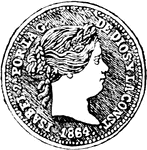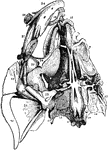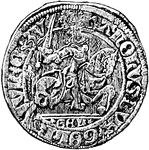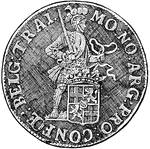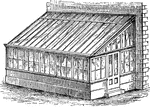
Plant House
"The glass roof is commonly designed so as to form a uniform plane or slope from back to front in lean-to…
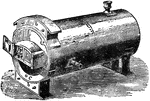
Trentham Boiler
"A very powerful and economical one, for large establishments especially. It is a modification of the…

Pyramid Pruning
"a shows a young tree with its second year's growth, the upright shoot of the maiden tree having been…

Gas Liquidation
"M. Cailleter's apparatus is represented. The gas under experiment is contained in a stout glass tube…

Gas Liquidation
"M. Cailleter's apparatus is represented. The gas under experiment is contained in a stout glass tube…

Aurelia Aurita
"Surface view of the sub-umbrella or oral aspect of Aurelia aurita, to show the position of the openings…
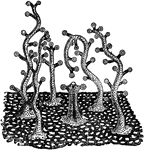
Millepora
"Enlarged view of the surface of a living Millepora, showing five dactylozooids surrounding a central…
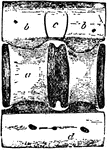
Shark Vertebra
"Lateral view of caudal vertebra of Basking Shark (Selache mazima). a, centrum; b, neurapophysis; c,…

Polypterus Skull
"Side view, with the membrane-bones. An, angular; ao, anteorbital; Ar, articulary; B, basal; D, dentary;…
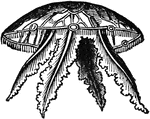
Acalephae
"Side-view, showing the tentacula hanging down in their natural position." — Chambers' Encyclopedia,…

Balcony
"A projecting gallery in front of a window or of several windows, with a balustrade or parapet before…
Barometer
"A cistern barometer, being that generally seen in weather-glasses or ordinary barometers. The tube…
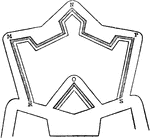
Crown-Work
"Crown-work, in Fortification, is formed to strengthen a weak front, or to occupy ground which might…

Rix Dollar
The front of a large silver coin used during the eighteenth century. Rigsdaler of Denmark.

Thysanuran
"A typical Thysanuran (Machilis maritima). Female, ventral view. Mx1, Mx2, 1st and 2nd maxillae. ii-x,…
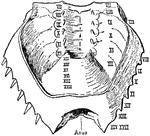
Limulus Polyphemus
"Ventral view of the posterior carapace or meso-metasomatic (opisthosomatic) fusion of Limulus polyphemus.…

Scorpion
"Ventral view of a scorpion. Palamnaeus indus, de Geer, to show the arrangement of the coxae of the…

Scorpio Embryo
"Embryo of scorpion, ventral view showing somites and appendages. sgc, Frontal groove. sa, Rudiment…

Limulus Polyphemus
"View of the ventral surface of the mid-line of the prosomatic region of Limulus polyphemus. The coxae…

Scorpion
"View from below of a scorpion (Buthus occitanus) opened and dissected so as to show the pericardium…
Scorpion
"Diagram of a lateral view of a longitudinal section of a scorpion. d, Chelicera. ch, Chela. cam, Camerostome.…

Limulus
"Diagram of a lateral view of a longitudinal section of Limulus. Suc, Suctorial pharynx. al, Alimentary…
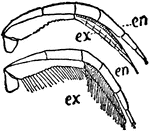
Triarthrus
"Triarthrus Becki, Green. Dorsal view of second thoracic leg with and without setae. en, Inner ramus;…

Limulus Polyphemus
"So-called "trilobite stage" of Limulus polyphemus. A, Dorsal; B, ventral view." — The Encyclopedia…

Limulus Polyphemus
"Ventral view of Limulus polyphemus. 1 to 6, The six prosomatic pairs of appendages. abd, the solid…

Eurypterus Fischeri
"Eurypterus Fischeri, Eichwald. Silurian of Rootzikil. Restoration after Schmidt. The dorsal aspect…

Palaophonus
"Dorsal view of a restoration of Palaeophonus nuncius, Thorell. The Silurian scorpion from Gothland."…

Palaeophonus Hunteri
"Ventral view of a restoration of Palaeophonus Hunteri, Pocock, the Silurian scorpion from Lesmahagow,…

Thelyphonus
"Thelyphonus, one of the Pedipalpi. A, Ventral view. I, Chelicera (detached). II, Chelae. III, Palpiform…

Thelyphonus
"Thelyphonus sp. Ventral view of the anterior portion of the body to show the three prosomatic sternal…

Schizomus
"Schizomus crassicaudaius, one of the Tartarid Pedipalpi. Ventral view of a female with the appendages…
Schizomus
"Schizomus crassicaudatus, a Tartarid Pedipalp. Dorsal view of a male with the appendages cut short.…
Schizomus
"Schizomus crassicaudatus, one of the Pedipalpi. Lateral view of a male, II to VI, the prosomatic appendages,…

Liphistius Desultor
"Liphistius desultor, Schiodte, one of the Araneae Mesothelae. Dorsal view. I to VI, the prosomatic…

Liphistius Desultor
"Liphistus desultor, Ventral view with the prosomatic appendages cut short expecting the chelicerae…

Liphistius Desultor
"Liphistius desultor. Lateral view. I to VI, Appendages of the prosoma cut off at the base. o, Ocular…

Spider
"Ventral view of a male mygalomorphous spider. I to VI, The six pairs of prosomatic appendages. a, Copulatory…

Koenenia Mirabilis
"Koenenia Mirabilis, Grassi, one of the Palpigradi. A, Ventral view of prosoma and of anterior region…

Galeodes
"Galeodes sp., one of the Solifugae. Ventral view to show legs and somites. I to VI, The six leg-bearing…

Galeodes
"Galeodes sp., one of the Solifugae. Ventral view with the appendages cut off at the base. I to VI,…
Galeodes
"Galeodes sp., one of the solifugae. Dorsal view. I to VI, Bases of the prosomatic appendages. o, Eyes.…

Garypus Litoralis
"Garypus litoralis, one of the Pseudoscorpiones. Ventral view. I to VI, Prosomatic appendages. o, Sterno-coxal…

Garypus Litoralis
"Garypus litoralis, one of the Pseudoscorpiones. Dorsal view. I to VI, The prosomatic appendages. o,…
Garypus Litoralis
"Garypus litoralis, one of the Pseudoscopions. Lateral view. I to VI, Basal segments of the six prosomatic…

Cryptostemma Karschii
"Cryptostemma Karschii, one of the Podogona. Dorsal view of male. III to VI, The third, fourth, fifth…

Cryptostemma Karschii
"Cryptostemma Karschii, one of the Podogona. Vental view. I to VI, The six pairs of appendages of the…
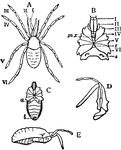
Stylocellus Sumatranus
"Stylocellus sumatranus, one of the Opiliones; after Thorell. Enlarged. A, Dorsal view; I to VI, the…
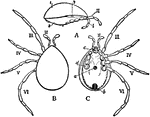
Holothyrus Nitidissimus
"Holothyrus nitidissimus, one of the Acari; ater Thorell. A, Lateral view with appendages III to VI…

Basilica
"Interior view of trajan's Basilica (Basilica Ulpia), as restored by Canina." — The Encyclopedia…

Basilica
"Sectional view of the old Basilica of St. Peter, before its destruction in the 16th century." —…

Womans Bike
"A lady's bicycle with gear-case and dress-guard. The rear frame of the "diamond" type is subjected…
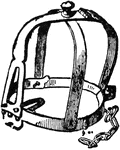
Brank
"Brank, or Branks, an instrument and formerly used in Scotland, and to some extent also in England,…
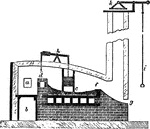
Puddling Furnace
"The general arrangement of a puddling furnace; a is the charging door for the fuel, d the bridge with…

Puddling Furnace
"The general arrangement of a puddling furnace; a is the charging door for the fuel, d the bridge with…
